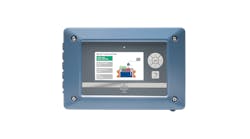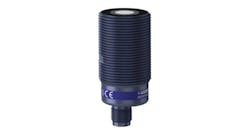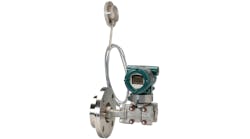[sidebar id =2]The overall physical characteristics of liquids, gases, slurries, intermediates, solids and aggregates don't change much, so it might seem like the methods for measuring their levels in tanks and other vessels wouldn't evolve much either. It's a logical assumption, but it's also wrong.
This is because many refinements in level measurement, like beam-narrowing 80-GHz non-contact radar and improved guided-wave-radar (GWR), as well as supporting technologies like wireless and better communications, are enabling more accurate level measurement and safety indications for more difficult, liquid/solid, foamy and vapor-blanketed substances in more challenging locations.
"Oil and gas prices are down, but that doesn't mean production can stop, so users need to increase efficiency by putting level measurement data on their networks," says Herman Coello, level marketing manager at Siemens process instrumentation group. "This requires fewer people, and prepares users for added profit when prices go back up."
Narrower beams, capable chips
"There are more innovations in level measurement and increasing use of communications, but we're also seeing high-cost technologies coming down to price levels where they're more reasonable for suppliers to put in products at less cost. This means more users can employ them, reduce total cost of ownership (TCO), and achieve safer, more reliable operations," says Dean Mallon, U.S. product manager for level at Endress+Hauser. "For instance, we're leading in innovating with 79-GHz, free-space radar, which uses frequency-modulated, constant-wave (FMCW). This non-contact technology has been around for many years, but it was cost-prohibitive until component and material costs began to come down recently. This is why 6-GHz or 26-GHz pulsed radar was traditionally used for level measurement."
Mallon explains that 6 GHz is a lower, broader frequency, so it's better at penetrating steam and vapor, while Endress+Hauser’s 26 GHz gets down to about a 12° beam, which is cost-effective (and has an encrypted Bluetooth link within 33 feet). "However, pulsed is different than FMCW, and can only do on, off and time gaps, while FMCW is a constant wave that amps up and down, achieves tighter, more focused energy, and allows 79 GHz to create its narrower, 3-4° beam," he says. "This means a better signal and more reliability on the reflection, so it can get into more substances, and avoid increased dispersal and absorption issues. However, there are so many variables, such as vessel height, agitation, foam and others, that we still need to test to determine which solution is best for each application."
Coello adds that Siemens’ Sitrans LR560 79-GHz, non-contact radar level components are popular in the grain industry because their 4° signal is so focused that they’re essentially unaffected by sidewalls and structural supports, but still provide continuous and dependent level measurements. “Many users didn’t have automated level measurement before, and could only make sporadic, manual measurementa,” adds Coello. “Now, they can tell what’s in their tanks and silos all the time. Also, because so many older engineers and operators are retiring, we’re making level devices as easy as possible to use, so younger personnel don’t have to be experts to configure them.”
Multitasking for redundancy
To reliably measure levels of flammable liquids and prevent overfills, chemical manufacturer and toll processor KMCO LLC in Crosby, Texas, recently sought to employ continuous measurement and high-level switches in tandem on some of its tanks. However, because these efforts can be hampered by space limits and added costs of multiple process connections, it asked Magnetrol for both technologies to be included in one 3-in. flange process connection. Open communication and accurate feedback allowed this combined design to be accommodated. GWR was chosened for continuous level, and paired with an ultrasonic gap switch for high-level indication. Both technologies are suitable in Safety Integrity Level (SIL) 2 loops. And, since KMCO also wanted wireless communications, both level devices were seamlessly integrated into a third-party wireless transmitter.
“Because of turnover of multiple products in the tanks, finding the right fit for a level transmitter was difficult,” says Daniel Charles, engineering manager at KMCO. “Our initial order was roughly 20 Magnetrol Eclipse 706 GWR transmitters. We were able to set them up in the shop, and install twice as many transmitters in half the time as competing models. The key to this is the 706 display, which we can navigate through quickly, and ensure that our setup is accurate.”
After installing the 20 units, Charles asked Magnetrol engineers if they could also fit a level switch in the flange assembly. “Our tanks have only one or two process connections on top, and using two ports for level indication is difficult,” explains Charles. “We use switches in all of our tanks to give operators redundant communications to prevent overfilling a vessel. KMCO is very focused on health, safety and environment (HS&E), and we take any step we can to prevent errors. Magnetrol got back to me with a design quickly, and we purchased the first batch of these units. The install was just as easy as with the 706s—all five were up in a day. These are now our go-to level transmitters, and they’ll be put on any future tank level project.”
Bob Botwinski, senior global product manager for radar and GWR at Magnetrol, adds, “There are very few companies in the process industries that haven’t been affected by low oil and gas prices in recent years. With that in mind, Magnetrol and others suppliers are concentrating more on chemical, power and other industries. In addition, new products and solutions such as KMCO’s are helping Magnetrol to diversify. Since releasing the first two-wire, 4-20 mA, loop-powered Model 705 GWR transmitter in 1998 and the most recent Model 706 GWR transmitter in 2013, we’ve been focusing on other technologies. In fact, this past January, Magnetrol introduced two new products: Model R96 non-contact radar transmitter and Jupiter JM4 magnetostrictive transmitter. Both of these transmitters are built on the Model 706 platform, and all have an intuitive user interface and proactive diagnostics.”
Beyond new products, Botwinski adds it’s just as important to talk to potential users about how these technologies can help solve their level measurement problems. “Magnetrol offers numerous level sensing technologies, so we don’t have to force fit a product into an application. Different technologies offer different advantages, which can often open people’s eyes to unusual conditions in their processes they really didn’t know existed. This is part of the reason why GWR and non-contact radar are becoming standard in industries worldwide,” he adds. “Back in the 1990’s, non-contact radar was thought to be the technology of the future. At that time, when GWR was introduced with its probe contacting the process medium, it was not thought to be revolutionary. However, the probe, originally considered to the weakness with GWR, has instead shown itself to be a major strength due to its signal reliability through vapors, foams and other difficult situations. More recently, radar level devices have added diagnostics and other proactive capabilities like automatic waveform capture to help users minimize downtime. Now, when a diagnostic event occurs at 1 or 2 a.m., level transmitters can automatically save date and time-stamped waveforms and other data that can be used for troubleshooting.”
Benefits from biomass
One primary reason why accurate level measurement and distributable data are so crucial is that many process applications have grown increasingly varied and non-traditional, so they need better data to maintain efficient control and operations. For instance, Drax Power Station in Selby, North Yorkshire, U.K., operates a multi-million-pound, co-firing facility, which burns low-carbon biomass alongside coal and enables Drax to produce 12.5% of its electricity from sustainable materials with reduced CO2 emissions.
The biomass facility receives, handles, stores and processes a variety of biomass materials, which are injected directly into coal-fired boilers. These feedstocks vary from forestry residues to cultivated products, such as Miscanthus and Willow, to agricultural byproducts like straw. The plant's storage facility includes two 12,000 cubic-meter silos, which must ensure the biomass is kept in optimum condition before use. This is important because biomass is lighter, has fluctuating handling properties, and generally lower variable bulk density, which requires larger storage facilities and presents other challenges, such as careful stock rotation/retention time to avoid degradation during the typical 24-48 hours before it's sent to the boilers.
[sidebar id =3]Drax reports its biomass silos are centrally filled by conveyor from railcars, and are emptied by rotary screw dischargers at their bottoms. This constant filling and discharging creates an uneven surface, which requires long-range level measurement, and reliance on non-contact radar level transmitters to avoid fouling and wear. As a result, Vega was asked to install its VegaPuls 68 non-contact radar level transmitters for solids, working over a range of approximately 27 meters (Figure 1). Two units are installed on each silo to provide average reading and dual-redundancy level measurement of the biomass.
The transmitters are mounted toward the center of the silos, aimed down and slightly outward to measure at an approximately half-radius point for good average level reading over the surface profile. Though the conveyor fill point is close, Vega reports its units work regardless of the filling stream. It adds there's no crosstalk with VegaPuls, even with multiple units in the same silo, due to dedicated pulse sampling filters. Drax adds the units have worked reliably for several years; provide data that facilitates available filling capacity for the rail transport department; and deliver stock supply data to the plant's control room to further optimize biomass supply.
Wellness with wireless
Beyond delivering operating and maintenance benefits, radar level measurement and its supporting technologies can also aid process safety efforts. For example, a petrochemical tank storage provider with facilities in several cities along the Yangtze River in China uses radar for continuous level measurement. However, a new standard for level monitoring recently recommended using an independent, overfill-prevention sensor for tank storage. As a result, because the provider’s engineers supported the standard, they decided to implement side-mounted Rosemount 2160 WirelessHART vibrating-fork level switches from Emerson Process Management on the sides of their fixed-roof storage tanks (Figure 2).
The tank provider installed 37 Rosemount 2160s to provide overfill protection with high-level alarms throughout its facility, which ensures an extra level of safety without the cost of added cabling. Data is collected by a Rosemount 1420 gateway that interfaces with the company's PLC via Modbus communications. The level switches also provide remote diagnostics and minimized installation costs because they didn't require cabling. The engineers report they observed the potential of migrating to wireless, and add this application was a simple way to evaluate, learn, and keep up with advances in instrumentation."On the face of it, level seems like a fairly straightforward measurement—it's not, and it’s fraught with application-specific issues that means many technologies aren't suited to those applications," says Tim Chettle, electromechanical business unit director of Emerson's Rosemount Measurement division. "Our customers can't be experts in everything, and that's why we encourage them to talk with us first. For instance, wireless instruments offer many examples of applications where customers have reaped large installation cost benefits. Our latest instruments have a host of on-board, self-checking and status diagnostics, which allow users to optimize maintenance routines, saving further costs."
Predictive, easier future
Finally, Mallon reports that Endress+Hauser's GWR and non-contact radar devices are also accomplishing predictive measurements thanks to on-board microprocessors running algorithms in conjunction with predefined parameters. These can help keep level applications operating, predicting process upsets before the loss of echoes. Contained in preconfigured diagnostic software blocks, predictive parameters can include electronics temperatures, voltage inputs, near-field/by-horn measurements, or relative echo amplitude, which is the strength of a returning signal.
"If the foam in a beer tank is very thick and we can't get an echo, then we can monitor the relative echo amplitude," says Mallon. "If its typical measurement decreases 10% due to foam, then we'll know it's happening again when we see that decrease. Previously, when a unit signal failed, operators had to wonder why the echo was lost, and go and find out. Now, we know what's going on, and can predict measurements before we lose a signal, run an output to a variable-frequency drive, and more accurately and reliably maintain level areas."






